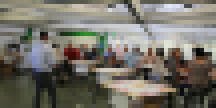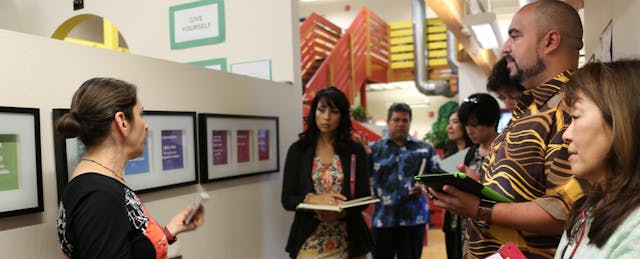Great. Another bogus professional development day with a guest speaker, a workshop, and a 50/50 chance that the lessons and/or message of the day will find its way into a classroom for any length of time.
Chances are, we’ve all sat through professional development exercises and wondered where the relevance for our own practice was. Sit-and-get PD rarely engages our interests and, at best, only temporarily sparks inspiration.
Considering neuroscience now suggests that the education system we grew up with has severe limitations, perhaps it’s time we reexamine how we approach teaching and learning, not just for students but for our educators as well. Teachers need professional development conducted with the same progressive techniques we hope to instill in students. This means more relevant topics targeted to teacher interests and needs, rather than fewer, spread out PD days in a one size fits all model.
In addition to revamping teaching practice, schools today are feeling increased pressure to transform their programs to keep pace with a changing society. For most, itʻs often like trying to turn an aircraft carrier around in a kiddie pool.
To address this challenge, The American School of Bombay (ASB) in India revamped its professional development model by taking a cue from the research and corporate world by creating its own "research and development" wing, a cohort of educators working together to make direct recommendations to school leadership, who would then oversee the implementation of these best practices in the daily operation of the school. The process was simple: have teachers research best practices through traditional means and by way of in situ observation and data collection. Then, implement these practices in their own settings and draw as many other teachers into the conversation and experimentation as possible.
The ASB book, "R&D Your School," was one that we at Kamehameha Schools in Honolulu took to heart. After reading and discussing it, we created our own version of the model pioneered at ASB called the Keala`ula (“the shining path”) Innovations Institute.
Envisioned as an instrument of transformational change across our three K-12 independent schools and 30 preschools for those with native Hawaiian ancestry across the state, we wanted to combine cutting edge teaching and learning practices with an R&D approach, as we saw opportunities for both teacher development and institutional guidance. For educators, the opportunity to contribute to both the larger school community and hone their practice in a personal way made the Keala`ula experience meaningful and empowering.
We developed our first project, the Keala`ula Cohort Program, to encourage teachers to explore individual curiosities about their craft in a safe, supportive and creative environment. We wanted to give them the rare opportunity to see innovation in action and build on their collective knowledge to help guide our schools. In our first year, the cohort consisted of 30 teachers and five high-level administrators who “audited” the program.
Our R&D institute was designed to let teachers guide their own professional development, but we also wanted a program that would help build educator relationships across our system, balance individual work with collaborative learning and establish a culture of growth. Teachers were responsible for choosing their own topics and for a data-based research and development project. But they would also receive regular, personalized attention from a coach. To us, exactly what teachers decided to focus on was less important than the collaboration and skills they would pick up along the way. We wanted to emphasize the journey over the destination.

A Community Approach
When designing our research and development program, we wanted a fast and loose process that didn't worry much about APA format or a 35 page paper or an Institutional Review Board. Instead, we relied on activities that were more tailored to participants and helped them collaborate with each other. We had teachers form campus work groups and take part in consultation and coaching sessions. We hosted an overnight kick-off retreat and then a concluding event to end things on the right note. And we made ample use of social media technology to have meaningful learning discussions asynchronously. We even established a private Facebook Workplace Community where teachers could ask questions and look for help, post interesting resources, engage in discussion, share their own action research and become familiar with what their peers were doing.
At the end of the year retreat, members shared their portfolios—the documentations of their learning journeys—with their peers, identifying the personal nature of their work. They told us that the community built within the group was a huge reason why the Keala`ula program impacted them so much. The freedom from “formalized” action research conditions allowed them to learn and respond quickly and to respond creatively, keeping their own learning process humming without being mired in details and useless extra work. Teachers liked the fact that they could dive right in and not worry about success or failure—only learning and creativity.
However, it was the addition of the research and development component that turned the Keala`ula experience from a great one into what one teacher called “a career changing journey, where I am now reinvigorated and see that all things are possible.” Our research and development component took the form of an all-cohort trip to see 11 innovative schools in the greater San Francisco area. While there, we visited Stanford (dSchool, YouCubed, and other programs) and Google. This trip was most directly valued by members because they actually saw and collected data on what they had been studying and acting on in their projects.
Furthermore having high level administrators auditing the program and participating in the trip was great for building relationships between leadership and the teachers at the front lines. At first, some of the teachers were hesitant to speak up when the leaders were around. But by the second day the conversations taking place were between educators as equals, not between supervisors and employees. The impact of this relationship building has been apparent as cohort members develop a “recommendation report” for our campuses based on what they saw and researched: They know their leaders are waiting expectantly to hear what they have to say.

Bringing It Home
By merging independent study action research PD with an R&D program we saw a variety of benefits extending beyond the teachersʻ personal and professional growth (which they identified as significant). Communication lines throughout the institution were improved as teachers were encouraged to use their colleagues as a resource, and trust their administratorsʻ willingness to listen to their ideas. Teachers felt empowered and honored. The community, skill development and momentum developed by the program has served as a springboard for cohort members to act locally in their schools to bring their learnings to other classrooms. But perhaps most importantly the merging of R&D with PD helped to clear the way for innovation and the development of a growth mindset.
So how can you make R&D PD happen in your school? Here are a few suggestions:
- Identify quality coaches who have a combination of administrative, teaching and innovative practice experience that can move seamlessly between the teacher world and the high level leadership world at your institution
- Recruit high flyers and budding stars as cohort members
- Keep costs down by looking at visits to local schools with innovative practices or programs before traveling to national/international destinations
- Remove restrictions on cohort members; let them do their thing
- Include leadership
- Create a venue for development work to be shared and for R&D to be more formally established, and
- Create places for cohort members to share with anyone, anywhere and everywhere.
Infusing research and development practices with self-directed PD teaches so much more than traditional sit-and-get techniques, and greatly increases teachers’ enthusiasm for their learning and growth. Executed correctly, an empowering PD/R&D program can amplify teacher voice and give it institutional influence—these are powerful seeds of transformation for both individual faculty members and your institution.


